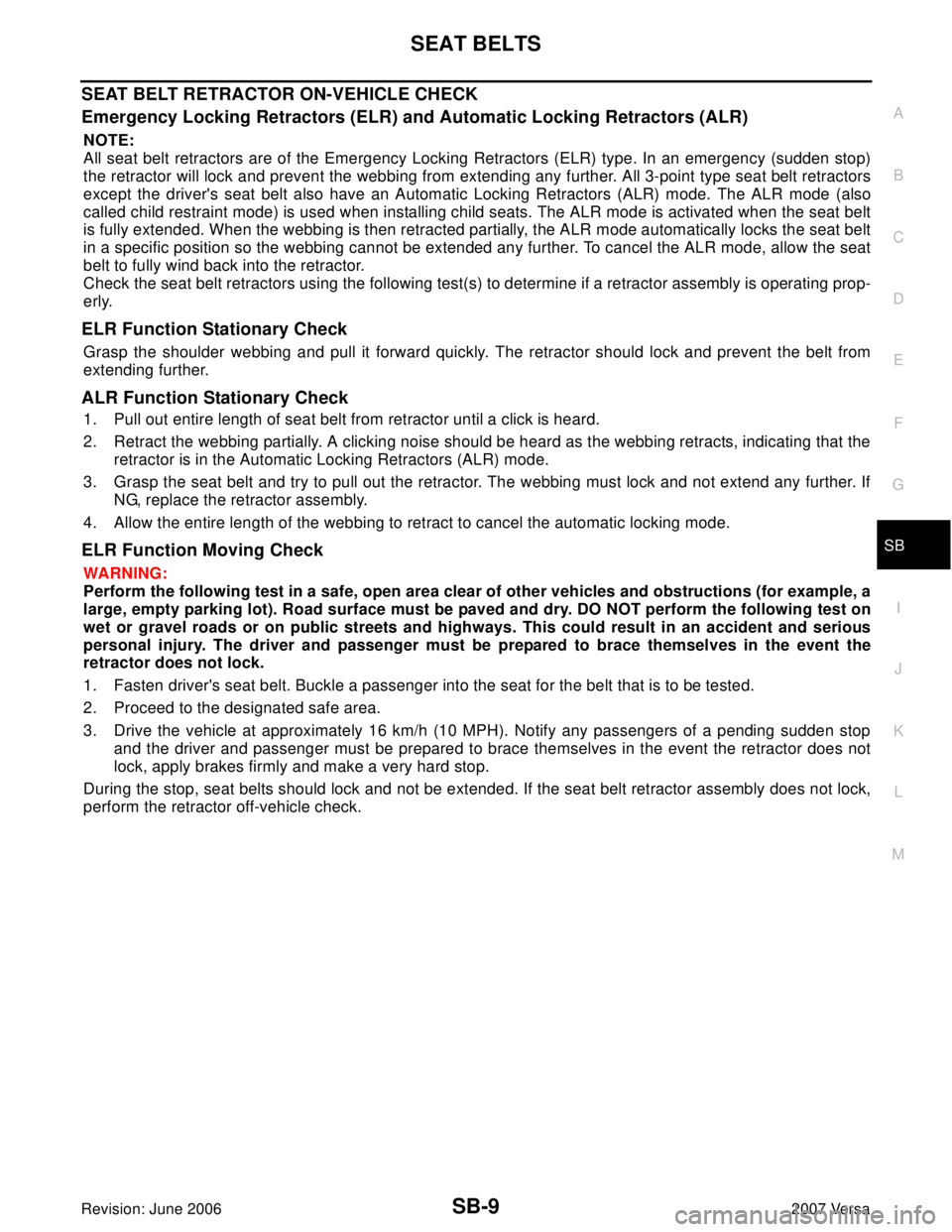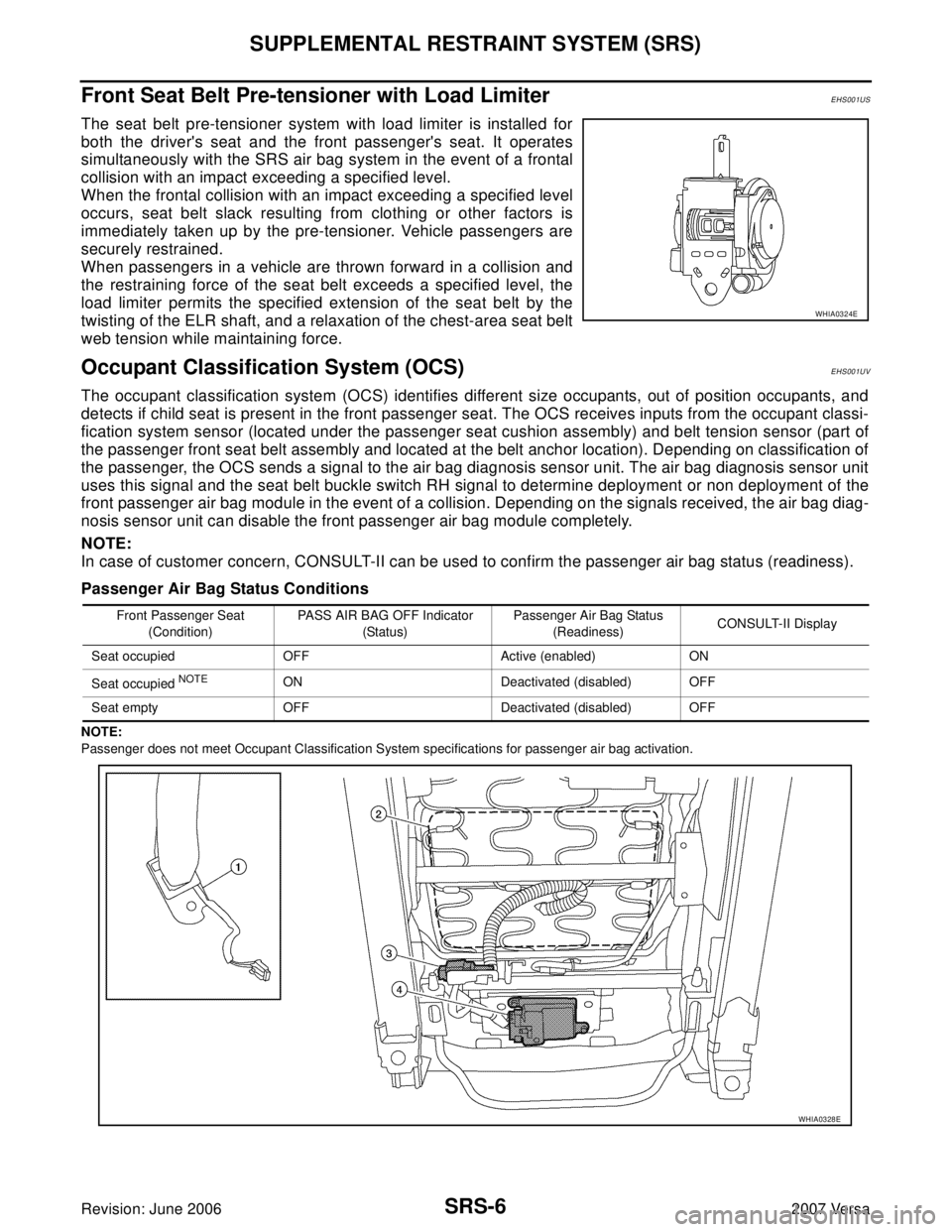2006 NISSAN VERSA child restraint
[x] Cancel search: child restraintPage 2663 of 2896

SB-1
SEAT BELTS
H RESTRAINTS
CONTENTS
C
D
E
F
G
I
J
K
L
M
SECTION SB
A
B
SB
Revision: June 20062007 Versa PRECAUTIONS .......................................................... 2
Precautions for Supplemental Restraint System
(SRS) “AIR BAG” and “SEAT BELT PRE-TEN-
SIONER” .................................................................. 2
Precaution for Seat Belt Service .............................. 2
AFTER A COLLISION ........................................... 2
SEAT BELTS .............................................................. 3
Removal and Installation of Front Seat Belt ............. 3
REMOVAL OF SEAT BELT RETRACTOR ............ 3
INSTALLATION OF SEAT BELT RETRACTOR ..... 4
REMOVAL OF SEAT BELT BUCKLE .................... 5
INSTALLATION OF SEAT BELT BUCKLE ............ 5
Removal and Installation of Rear Seat Belt ............. 6
REMOVAL OF OUTER SEAT BELT RETRAC-
TOR ....................................................................... 6
INSTALLATION OF OUTER SEAT BELT
RETRACTOR ........................................................ 6
REMOVAL OF CENTER SEAT BELT RETRAC-TOR ....................................................................... 6
INSTALLATION OF CENTER SEAT BELT
RETRACTOR ........................................................ 6
REMOVAL OF SEAT BELT BUCKLE .................... 6
INSTALLATION OF SEAT BELT BUCKLE ............ 7
Seat Belt Inspection .................................................. 8
AFTER A COLLISION ........................................... 8
PRELIMINARY CHECKS ...................................... 8
SEAT BELT RETRACTOR ON-VEHICLE
CHECK .................................................................. 9
SEAT BELT RETRACTOR OFF-VEHICLE
CHECK ................................................................ 10
LATCH (LOWER ANCHORS AND TETHER FOR
CHILDREN) SYSTEM ............................................... 11
Removal and Installation ........................................ 11
TOP TETHER STRAP CHILD RESTRAINT ............. 12
Removal and Installation ........................................ 12
Page 2671 of 2896

SEAT BELTS
SB-9
C
D
E
F
G
I
J
K
L
MA
B
SB
Revision: June 20062007 Versa
SEAT BELT RETRACTOR ON-VEHICLE CHECK
Emergency Locking Retractors (ELR) and Automatic Locking Retractors (ALR)
NOTE:
All seat belt retractors are of the Emergency Locking Retractors (ELR) type. In an emergency (sudden stop)
the retractor will lock and prevent the webbing from extending any further. All 3-point type seat belt retractors
except the driver's seat belt also have an Automatic Locking Retractors (ALR) mode. The ALR mode (also
called child restraint mode) is used when installing child seats. The ALR mode is activated when the seat belt
is fully extended. When the webbing is then retracted partially, the ALR mode automatically locks the seat belt
in a specific position so the webbing cannot be extended any further. To cancel the ALR mode, allow the seat
belt to fully wind back into the retractor.
Check the seat belt retractors using the following test(s) to determine if a retractor assembly is operating prop-
erly.
ELR Function Stationary Check
Grasp the shoulder webbing and pull it forward quickly. The retractor should lock and prevent the belt from
extending further.
ALR Function Stationary Check
1. Pull out entire length of seat belt from retractor until a click is heard.
2. Retract the webbing partially. A clicking noise should be heard as the webbing retracts, indicating that the
retractor is in the Automatic Locking Retractors (ALR) mode.
3. Grasp the seat belt and try to pull out the retractor. The webbing must lock and not extend any further. If
NG, replace the retractor assembly.
4. Allow the entire length of the webbing to retract to cancel the automatic locking mode.
ELR Function Moving Check
WA RN ING:
Perform the following test in a safe, open area clear of other vehicles and obstructions (for example, a
large, empty parking lot). Road surface must be paved and dry. DO NOT perform the following test on
wet or gravel roads or on public streets and highways. This could result in an accident and serious
personal injury. The driver and passenger must be prepared to brace themselves in the event the
retractor does not lock.
1. Fasten driver's seat belt. Buckle a passenger into the seat for the belt that is to be tested.
2. Proceed to the designated safe area.
3. Drive the vehicle at approximately 16 km/h (10 MPH). Notify any passengers of a pending sudden stop
and the driver and passenger must be prepared to brace themselves in the event the retractor does not
lock, apply brakes firmly and make a very hard stop.
During the stop, seat belts should lock and not be extended. If the seat belt retractor assembly does not lock,
perform the retractor off-vehicle check.
Page 2674 of 2896

SB-12
TOP TETHER STRAP CHILD RESTRAINT
Revision: June 20062007 Versa
TOP TETHER STRAP CHILD RESTRAINTPFP:88000
Removal and InstallationEHS001VG
NOTE:
The top tether strap child restraint is not serviceable.
Page 2734 of 2896

SRS-6
SUPPLEMENTAL RESTRAINT SYSTEM (SRS)
Revision: June 20062007 Versa
Front Seat Belt Pre-tensioner with Load LimiterEHS001US
The seat belt pre-tensioner system with load limiter is installed for
both the driver's seat and the front passenger's seat. It operates
simultaneously with the SRS air bag system in the event of a frontal
collision with an impact exceeding a specified level.
When the frontal collision with an impact exceeding a specified level
occurs, seat belt slack resulting from clothing or other factors is
immediately taken up by the pre-tensioner. Vehicle passengers are
securely restrained.
When passengers in a vehicle are thrown forward in a collision and
the restraining force of the seat belt exceeds a specified level, the
load limiter permits the specified extension of the seat belt by the
twisting of the ELR shaft, and a relaxation of the chest-area seat belt
web tension while maintaining force.
Occupant Classification System (OCS)EHS001UV
The occupant classification system (OCS) identifies different size occupants, out of position occupants, and
detects if child seat is present in the front passenger seat. The OCS receives inputs from the occupant classi-
fication system sensor (located under the passenger seat cushion assembly) and belt tension sensor (part of
the passenger front seat belt assembly and located at the belt anchor location). Depending on classification of
the passenger, the OCS sends a signal to the air bag diagnosis sensor unit. The air bag diagnosis sensor unit
uses this signal and the seat belt buckle switch RH signal to determine deployment or non deployment of the
front passenger air bag module in the event of a collision. Depending on the signals received, the air bag diag-
nosis sensor unit can disable the front passenger air bag module completely.
NOTE:
In case of customer concern, CONSULT-II can be used to confirm the passenger air bag status (readiness).
Passenger Air Bag Status Conditions
NOTE:
Passenger does not meet Occupant Classification System specifications for passenger air bag activation.
WHIA0324E
Front Passenger Seat
(Condition)PASS AIR BAG OFF Indicator
(Status)Passenger Air Bag Status
(Readiness)CONSULT-II Display
Seat occupied OFF Active (enabled) ON
Seat occupied
NOTEON Deactivated (disabled) OFF
Seat empty OFF Deactivated (disabled) OFF
WHIA0328E